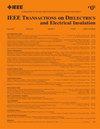Acoustic Emission and Propagation Characteristics of Metal Particles in GIS
IF 3.1
3区 工程技术
Q2 ENGINEERING, ELECTRICAL & ELECTRONIC
IEEE Transactions on Dielectrics and Electrical Insulation
Pub Date : 2024-11-15
DOI:10.1109/TDEI.2024.3499895
引用次数: 0
Abstract
Metal particle pollution was one of the significant factors that endangered the reliability of the gas-insulated switchgears (GISs). The detection of metal particles in GIS was crucial for ensuring the safe operation of GIS. This article established a calculation model for the cut-off frequency of acoustic emission (AE) generated by the metal particle collision with the GIS enclosure. The effects of metal particle materials, the Gaussian equivalent radius, and the bounce heights on the cut-off frequency of the AE signal were obtained. Through the AE measurement experiments of metal particle colliding with an aluminum plate, the accuracy of the cut-off frequency calculation model was verified. Besides, the experiment confirmed that the propagation mode of the AE signal on GIS enclosure was primarily the S0 mode Lamb wave. The attenuation of the AE signal was analyzed. The geometric attenuation and the energy loss attenuation were determined as the primary attenuation processes. A calculation model for the attenuation of AE signal was established. Based on this, the variation of the cut-off frequency after propagation on the GIS enclosure was clarified. The AE and propagation characteristic proposed in this article provided guidance for optimizing the frequency band of ultrasonic sensors and setting up the measurement points.GIS中金属颗粒的声发射与传播特性
金属颗粒污染是影响气体绝缘开关设备可靠性的重要因素之一。地理信息系统中金属颗粒的检测是保证地理信息系统安全运行的关键。本文建立了金属颗粒与GIS围护体碰撞时声发射截止频率的计算模型。得到了金属颗粒材料、高斯等效半径和弹跳高度对声发射信号截止频率的影响。通过金属颗粒与铝板碰撞的声发射测量实验,验证了截止频率计算模型的准确性。此外,实验还证实了声发射信号在GIS机箱上的传播方式主要是S0模态兰姆波。分析了声发射信号的衰减特性。确定几何衰减和能量损耗衰减为主要衰减过程。建立了声发射信号衰减的计算模型。在此基础上,阐明了截止频率在GIS机箱上传播后的变化规律。本文提出的声发射和传播特性对超声波传感器的频段优化和测点设置具有指导意义。
本文章由计算机程序翻译,如有差异,请以英文原文为准。
求助全文
约1分钟内获得全文
求助全文
来源期刊
CiteScore
6.00
自引率
22.60%
发文量
309
审稿时长
5.2 months
期刊介绍:
Topics that are concerned with dielectric phenomena and measurements, with development and characterization of gaseous, vacuum, liquid and solid electrical insulating materials and systems; and with utilization of these materials in circuits and systems under condition of use.

 求助内容:
求助内容: 应助结果提醒方式:
应助结果提醒方式:


